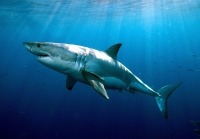
(Photo: Gregory Skomal)
Great White Shark
Carcharodon carcharias
This large shark has an average body length of 4.6 metres. It has a cone-shaped snout and symmetrical, triangular teeth. It has a notable white underside to which it owes its name. Like other sharks within the same family, it has a distinctive keel (ridge) on its caudal peduncle (the part that joins its tail to its body). This keel aids in rapid acceleration. The upper and lower halves of their tail (caudal) fin are similar in size.
Authority
Linnaeus, 1758
Classification Details
Phylum: Chordata (chordates); Subphylum: Vertebrata (vertebrates); Class: Elasmobranchii (sharks, skates, and rays).
Habitat
Found worldwide, from tropical to cool waters. Although rare in Canadian waters, there are a few sightings every year. On the east coast of Canada, they inhabit the Bay of Fundy, Nova Scotia, Newfoundland, and the Gulf of St. Lawrence.
Diet
They eat fish and marine mammals. Prey includes salmon, mackerel, tuna, harbour porpoises, and seals. Stomach content analysis revealed that a great white shark caught off Deer Island, NB had eaten three porpoises. They are also opportunistic scavengers and will feed on whale carcasses.
Reproduction
Sexes are separate with internal fertilization. Males inseminate the females via their claspers, located on the outside of the body. Great white sharks are ovoviviparous. This means they have eggs that hatch within the body. The mother then gives birth to two to 14 live young. Males reach sexual maturity at 10 years of age, while it takes females 12 to 14 years to mature. Scientists think that there may be a breeding area off of Cape Cod in the USA. Can live for more than 70 years.
Fun Facts
Juvenile white sharks start out with sharp, pointed teeth made for targeting fish. Mature white sharks have triangular teeth with serrated edges, which are characteristic of this species. These teeth are better able to take chunks of flesh from marine mammals.
Great white sharks are an endangered species. They face a variety of threats including being caught as accidental bycatch, for the finning fishery, and as trophies.
References
DFO. White Shark (Atlantic Population). https://species-registry.canada.ca/index-en.html#/species/899-633 Accessed online 20 January 2020. IUCN. IUCN Red List. White Shark Carcharodon carcharias. https://www.iucnredlist.org/species/3855/2878674 Accessed online 20 January 2020. Skomal G (2016) The Shark Handbook. 2nd edition. Kennebunkport: Cider Mill Press Book Publishers.

